Natural oils fade from your soap bars because they're volatile compounds that easily evaporate over time. The high temperatures and chemical reactions during saponification can break down these delicate oils, while environmental factors like heat, light, and humidity accelerate the fading process. You'll notice citrus scents disappear particularly fast due to their lightweight molecular structure. Understanding proper storage techniques and anchoring methods can help you preserve those precious fragrances for longer.
Understanding Essential Oil Volatility in Soap
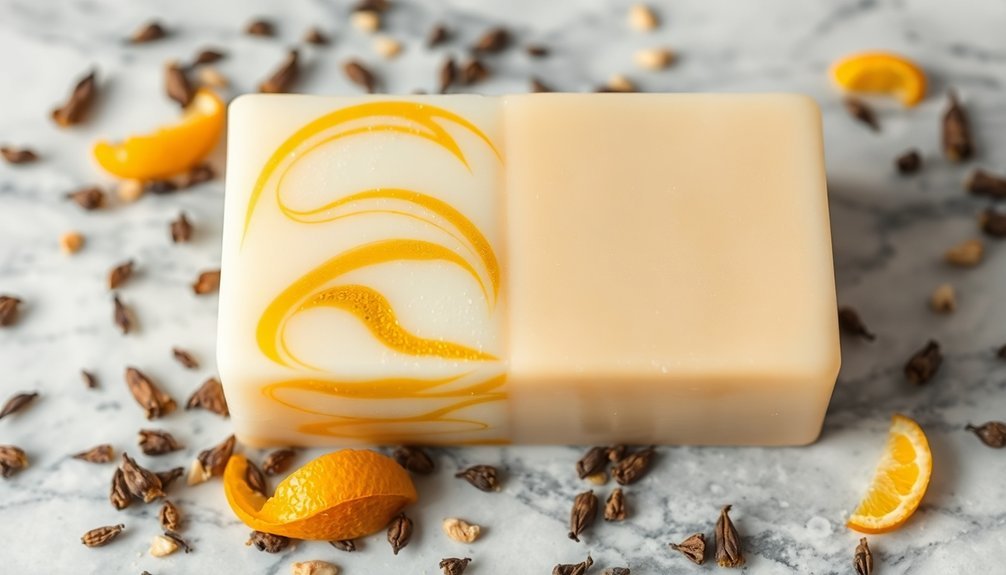
When you work with essential oils in soap making, understanding their volatile nature becomes essential for achieving lasting fragrances. These natural compounds readily evaporate, which explains why you'll notice scent fade in your soap bars over time. This process accelerates when you don't store your soaps properly.
The chemistry behind essential oils plays a significant role in their stability. You'll find that oils with lower flashpoints evaporate more quickly, while the saponification process itself can alter their chemical structure.
This is particularly true for citrus essential oils, which fade faster due to their lightweight molecular composition. To minimize this effect, you'll want to keep your soaps in a cool, dry environment away from direct sunlight, helping preserve their fragrance for a longer period.
Chemical Reactions During Saponification
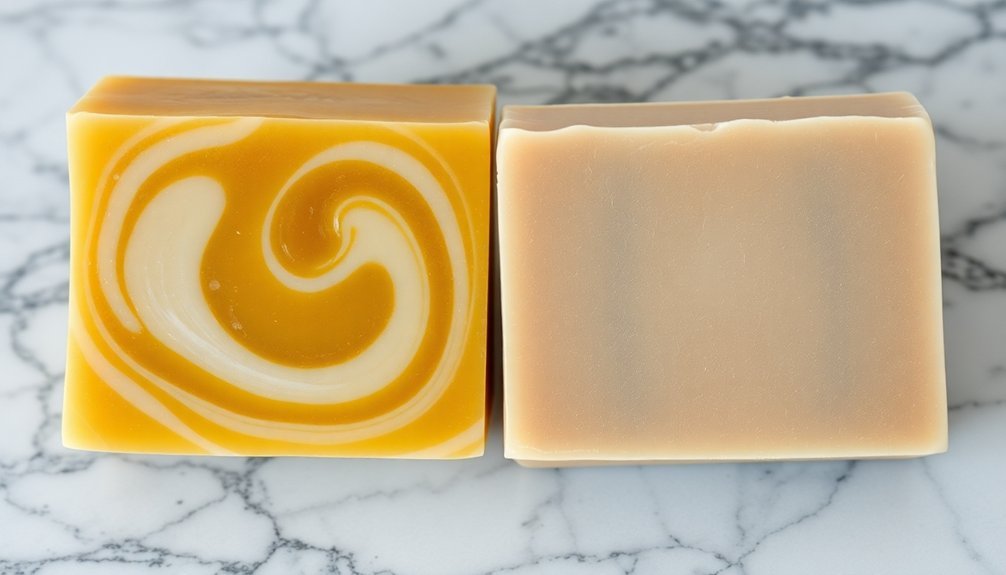
As essential oils undergo saponification, their chemical structures face significant changes that can impact their fragrance profiles. You'll notice scent fading occurs when lye reacts with fats at high temperatures, causing volatile compounds to break down or evaporate. The pH levels during this process can further destabilize your essential oils, altering their original aromatic properties.
| Process Stage | Chemical Effect | Impact on Scent |
|---|---|---|
| Initial Mixing | Lye-Fat Reaction | Slight Weakening |
| Heat Phase | Molecular Breakdown | Major Volatilization |
| pH Adjustment | Chemical Alteration | Aroma Changes |
| Curing | Continued Reaction | Progressive Fading |
To maintain stronger fragrances in your soap, you'll need to take into account the flashpoints of your chosen essential oils and adjust their concentrations accordingly, as oils with lower flashpoints are more susceptible to evaporation during saponification.
Impact of Environmental Factors on Scent
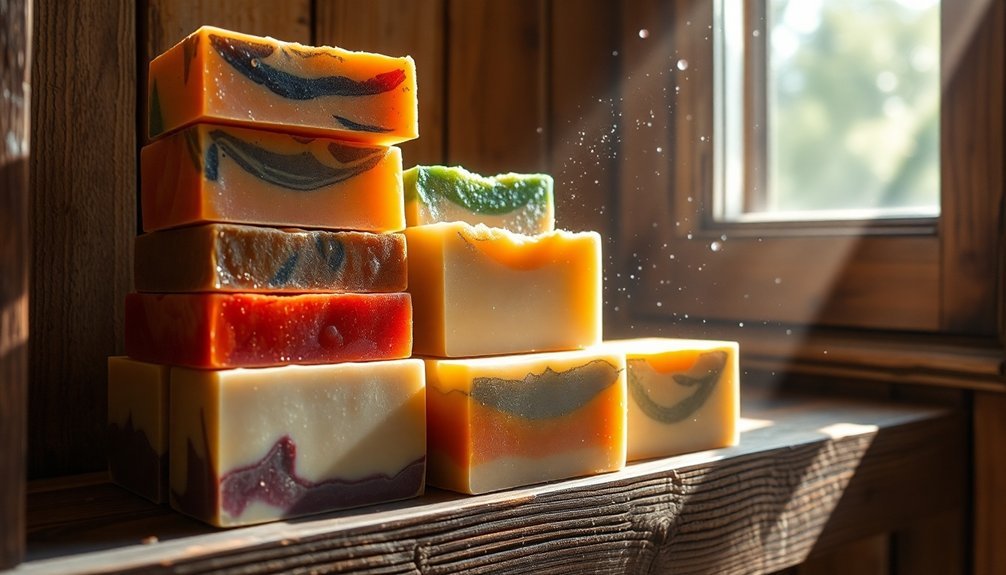
Your soap's natural fragrance will weaken faster when exposed to direct sunlight and high temperatures, as these conditions speed up essential oil evaporation.
High humidity levels in your storage area can break down the aromatic compounds in your soap bars, leading to premature scent loss.
You'll notice this effect most prominently in citrus-scented soaps, which are particularly vulnerable to environmental factors and require storage in cool, dry, dark places to maintain their fragrance.
Temperature and Light Exposure
How carefully you store your soap bars can make or break their signature scents. When you expose your soaps to direct sunlight, UV rays break down essential oil molecules, causing fragrances to fade more rapidly than they should.
Similarly, high temperature exposure can trigger premature evaporation and oxidation of these delicate compounds.
You'll need to be strategic about where you keep your soaps to preserve their aromatic qualities. Choose a cool, dry storage spot away from windows and heat sources.
This is especially important for soaps containing essential oils with low flashpoints, as they're particularly sensitive to temperature fluctuations.
Remember that proper storage isn't just about convenience – it's about protecting the volatile compounds that give your soap its distinctive scent from unnecessary environmental stress.
Storage Humidity Effects
When soap bars absorb moisture from humid environments, their carefully crafted scents begin to deteriorate. Your soaps are particularly vulnerable to humidity's effects, as excess moisture can dilute the essential oils responsible for their signature fragrances.
When humidity levels fluctuate, you'll notice your soap's scents fade more quickly due to chemical reactions between water molecules and fragrance compounds.
To protect your soap's natural oils, you'll want to store them in a consistently dry environment. High humidity combined with temperature changes and sunlight exposure creates perfect conditions for scent degradation.
You can preserve your soap's aromatic qualities by keeping them in a cool, dry space away from moisture. This simple storage solution helps prevent the premature evaporation of volatile scent components, ensuring your soaps maintain their intended fragrance longer.
Proper Essential Oil Measurements and Ratios

Measuring essential oils accurately in soap making is essential for both safety and effectiveness.
You'll want to follow the standard usage rate of 1 ounce per pound of soaping oils, but remember that specific oils like Cherry Almond require lower amounts – no more than 0.2 ounces per pound to prevent skin irritation.
While it's tempting to double essential oil quantities for stronger scents, this can lead to skin sensitivity issues.
Instead, focus on creating well-balanced blends that include middle and base notes to improve scent retention.
You'll notice that certain oils, particularly citrus and eucalyptus, tend to fade within five days of soap making.
That's why proper measurements aren't just about safety – they're important for achieving lasting fragrance in your final product.
Temperature Control During Production
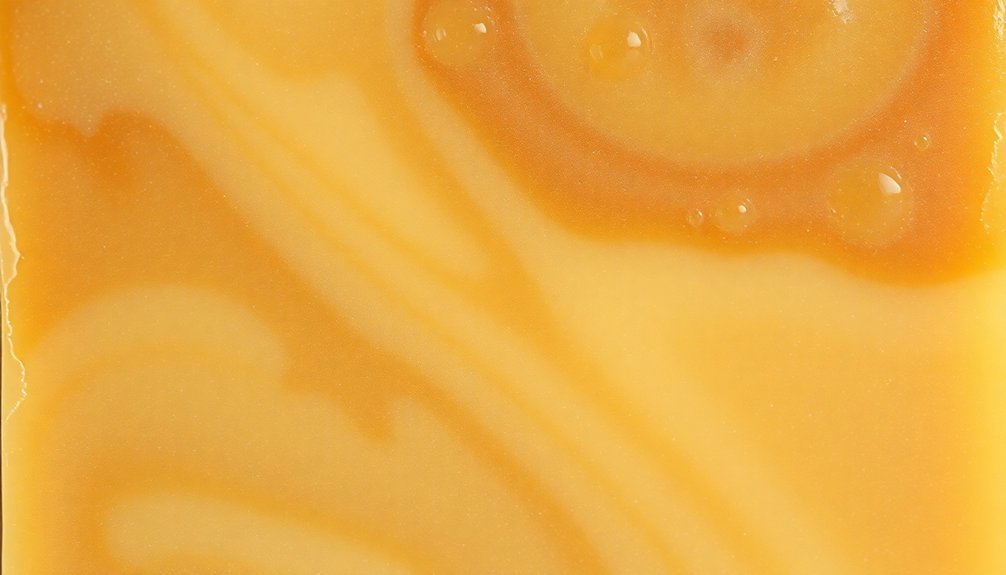
Your careful monitoring of temperature during soap production will directly affect how well your essential oils retain their scents.
If you let temperatures climb too high during the gel phase (160-200°F), you'll risk your fragrances evaporating or chemically altering, especially with lighter essential oils that have lower flash points.
You'll get the best scent retention by keeping temperatures regulated throughout the process and choosing high-flash-point fragrance oils when working with hot process methods.
Heat Impact on Scents
Temperature control plays an essential role in preserving the aromatic qualities of natural oils during soap production. When you're making soap, you'll need to carefully monitor heat levels to prevent essential oils from evaporating.
During the gel phase, temperatures can climb between 160°F and 200°F, which can cause your carefully selected scents to dissipate.
To protect your fragrances from heat impact on scents, you'll want to add essential oils at trace rather than mixing them with the lye solution. This timing helps prevent unwanted chemical reactions that could alter your soap's aromatic profile.
If you're using hot process methods, choose high flashpoint oils for better scent retention. Lower flashpoint oils will quickly evaporate when exposed to high temperatures, leaving you with a less fragrant final product.
Optimal Temperature Range
When crafting soap with natural oils, maintaining precise temperature control between 70°F to 85°F (21°C to 29°C) guarantees successful saponification and maximizes fragrance retention.
You'll find that this ideal temperature range helps prevent your essential oils from evaporating during the vital mixing and pouring stages.
If you're working with fragrances that have low flashpoints, you'll need to add them at cooler temperatures to prevent the scent from burning off.
While higher temperatures during the gel phase can boost scent throw, they can also damage delicate fragrance notes if not properly monitored.
To enhance your soap's lasting scent, consider using high flashpoint oils in hot process methods, as they're more resistant to evaporation.
This careful temperature control throughout production guarantees your natural oils remain stable and aromatic in the finished product.
Preventing Flash Point Issues
Successful fragrance retention in soap making hinges on understanding flash point temperatures for your essential oils.
You'll need to carefully monitor your production temperatures to prevent scent evaporation, especially during critical phases like saponification.
To protect your essential oils, don't add them when temperatures are too high. Most essential oils have flashpoints below 200°F, so you'll want to wait until the trace phase in cold process soap making.
For hot process methods, select oils with higher flashpoints to maintain scent integrity throughout the heating process.
Never let your temperatures exceed 300°F, as this will cause your fragrances to evaporate rapidly.
Anchoring Techniques for Lasting Fragrance
The art of anchoring fragrances in soap bars requires strategic blending of essential oils to maximize their staying power. You'll find success by combining lighter, volatile scents like citrus with deeper, earthier essential oils such as patchouli or sandalwood. This creates a balanced profile that helps prevent premature scent fading.
To enhance your anchoring techniques, try incorporating cornstarch at one tablespoon per pound of oils. You can also add kaolin clay, which not only improves slip but helps lock in those precious scents.
If you're working with citrus oils, consider using concentrated versions like Orange 5X for better longevity. When you pair these methods with well-rounded essential oil blends that include middle and base notes, you'll achieve a more stable and lasting fragrance in your final soap bars.
Clay Addition Methods for Scent Retention
By incorporating kaolin clay into your soap formulations, you'll enhance both fragrance retention and the overall quality of your bars.
Adding one tablespoon of kaolin clay per pound of soaping oils can make a significant difference in how long your essential oils last in the final product.
You'll find that kaolin clay works as a natural scent anchor by absorbing and holding onto essential oils throughout the curing process.
To maximize its effectiveness, mix the clay with your fragrance components before adding them to your soap batch.
While results may vary depending on the specific essential oils you're using, this method typically produces more balanced and longer-lasting scent profiles.
Don't hesitate to experiment with different clay types to discover which works best with your particular soap recipes.
Storage Solutions for Maximum Longevity
Proper storage plays an essential role in preserving your soap's fragrance and overall quality. To prevent scent fading, you'll want to keep your soap bars in a cool, dry environment away from direct sunlight, as heat and light can quickly break down fragrance oils.
Your best storage solutions include placing soaps in drawers or dark closets, which protect them from environmental factors that diminish their scent.
If you've just received a shipment, consider keeping the bars in their original boxes until you're ready to use them – this provides extra protection against light and air exposure.
Don't forget to monitor your inventory and avoid making too much soap at once, as fragrances typically begin fading within one to two years of production.
Natural Preservatives and Stabilizers
You'll find kaolin clay acts as a powerful natural anchor that locks fragrance oils into your handmade soap, extending their longevity throughout use.
Natural fixatives like beeswax and soy lecithin work alongside plant-based preservatives to maintain the stability of essential oils in your soap formulations.
Cornstarch serves as an effective dry additive that helps distribute fragrances evenly while preventing their premature evaporation during the vital curing phase.
Clay For Scent Retention
Natural soap makers have discovered that kaolin clay serves as an effective scent retention aid, helping essential oils and fragrances last longer in finished soap bars. When you add kaolin clay to your soap formulation, it absorbs the essential oils and reduces their evaporation during the curing process, ultimately preserving their scent.
You'll find that kaolin clay doesn't just help with fragrance retention – it also adds a smooth, silky texture to your soap and provides a subtle, natural color.
To maximize scent retention, you can combine kaolin clay with cornstarch, using up to 1 tablespoon per pound of oils. This combination helps anchor both light and heavy fragrance notes.
Don't be afraid to experiment with different clay amounts and combinations to find what works best for your specific soap recipe.
Natural Anchoring Methods
When creating lasting soap fragrances, several natural anchoring methods can stabilize essential oils without synthetic additives.
You'll find that cornstarch effectively binds fragrances while improving your soap's lather quality. Another reliable option is arrowroot powder, which not only extends scent longevity but also enhances the soap's texture.
To maximize scent retention, blend your essential oils strategically. Combine volatile citrus oils with stable base notes like patchouli or sandalwood.
These well-rounded essential oil blends create a more lasting fragrance profile in your final product. You can also incorporate kaolin clay, which works as a natural anchor by absorbing the oils while adding a subtle color and slip to your soap.
These natural stabilizers help guarantee your handcrafted soaps maintain their appealing scent longer.
Plant-Based Fixative Options
Several plant-based fixatives serve as excellent natural preservatives and stabilizers in soap making.
You'll find orris root and benzoin resin particularly effective at enhancing and prolonging your soap's fragrance by helping retain scent molecules.
Natural resins like frankincense and myrrh provide dual benefits of scent enhancement and preservation.
When you're working with essential oils, consider incorporating vetiver or patchouli as natural anchors.
These oils excel at holding lighter scents in place and extending overall fragrance life.
You can also blend them with heavier oils like sandalwood or cedarwood to create more balanced, longer-lasting scent profiles.
For additional retention benefits, try adding kaolin clay to your soap formulation – it helps absorb and hold essential oils while adding beneficial slip properties.
Blending Strategies for Stronger Scents
Creating lasting scents in soap requires strategic blending of essential oils to achieve the perfect balance of strength and longevity.
You'll get better results by combining lighter fragrance oils with deeper, earthier ones like patchouli or sandalwood, which act as natural anchors for the scent.
To maximize the impact of citrus essential oils, opt for concentrated versions like Orange 5X. You can enhance scent retention by incorporating dry additives such as kaolin clay or cornstarch, which help absorb and lock in the fragrance.
Concentrated citrus oils and natural absorbents like kaolin clay create longer-lasting, vibrant fragrances in handcrafted soaps.
When blending, adjust your ratios carefully – lighter oils typically need higher concentrations to match stronger base notes.
Try creating well-rounded combinations using middle notes like litsea cubeba and base notes like ginger or patchouli to prevent premature fading and guarantee your soap maintains its delightful aroma.
Water Content Effects on Oil Stability
The delicate balance between water and essential oils plays a vital role in maintaining fragrance stability within your soap bars. When you're crafting soap, high water content can considerably weaken your essential oils' strength and accelerate scent fading.
You'll find that excess water dilutes the concentration of these natural fragrances, making it harder to achieve the lasting scent you desire.
During the saponification process, water interactions can alter your essential oils' chemical structure, affecting their stability and retention. If you're noticing your soap's fragrance disappearing quickly, your water-to-oil ratio might be off.
To preserve the scent profile you've carefully created, you'll need to maintain ideal water levels. Remember that controlling water content isn't just about consistency – it's essential for protecting your essential oils' integrity and ensuring long-lasting fragrance.
Curing Time and Scent Development
While your soap bars undergo the crucial curing process, you'll notice significant changes in their fragrance profile over time. The typical four-week curing time presents both challenges and opportunities for scent development, especially when you're working with essential oils that tend to fade quickly.
To maintain ideal fragrance during the curing period:
- Store your soaps in a cool, dry environment away from direct sunlight to protect the volatile essential oils.
- Consider producing smaller batches to maintain better control over scent stability.
- Monitor the first five days closely, as this is when most essential oils experience significant fade.
- Avoid extended storage periods beyond the necessary curing time, as this can lead to continued evaporation.
Your careful attention to these curing conditions will help preserve the natural fragrances and guarantee your soap maintains its intended aroma.
Testing Methods for Fragrance Duration
Proper testing of fragrance duration in your soap bars builds upon successful curing practices.
Testing fragrance longevity requires mastering the curing process first – it's the foundation for creating lasting, well-scented soaps.
You'll want to monitor your soaps at specific intervals – typically at one week, four weeks, and throughout the year – to track how well the scents hold up over time.
When implementing testing methods, start with small batches to maintain better control over variables.
This is especially important when working with essential oils like eucalyptus and grapefruit, which can fade within five days.
You'll need to pay particular attention to cold process soaps, as their high gel phase temperatures can affect fragrance retention.
To get accurate results, consistently evaluate your soap bars' scent strength and document any changes.
This data will help you adjust your recipes and select oils with higher flashpoints for improved longevity.
Frequently Asked Questions
Why Does Oil Disappear in Soap?
Your soap's oils fade because they're volatile compounds that'll evaporate during saponification and storage. Heat, light, and chemical reactions break down the fragrant molecules, making them disappear from your finished soap bar.
Why Does Bar Soap Lose Its Scent?
Your bar soap loses its scent because essential and fragrance oils naturally evaporate over time. You'll notice this happens faster with citrus scents, and it's accelerated by heat, light, and the soap-making process itself.
How to Make Essential Oils Last Longer in Soap?
You'll get longer-lasting scents by adding essential oils at trace, pairing lighter oils with earthier ones, using kaolin clay as an anchor, measuring proper usage rates, and storing finished soaps in cool, dark places.
How to Prevent Scent Fading in Soap?
You'll prevent scent fading by using 0.7-0.8 oz of fragrance per pound of soap, adding kaolin clay, blending with earthy base notes, and storing bars in a cool, dry place away from sunlight.
In Summary
You'll find that natural oils fade from soap bars due to several factors: their inherent volatility, chemical changes during saponification, and environmental exposure. To maintain stronger scents, you need to carefully measure oils, control temperatures, and allow proper curing time. Through strategic blending and proper water ratios, you can maximize fragrance retention, but remember that some fading is natural and expected in handmade soaps.

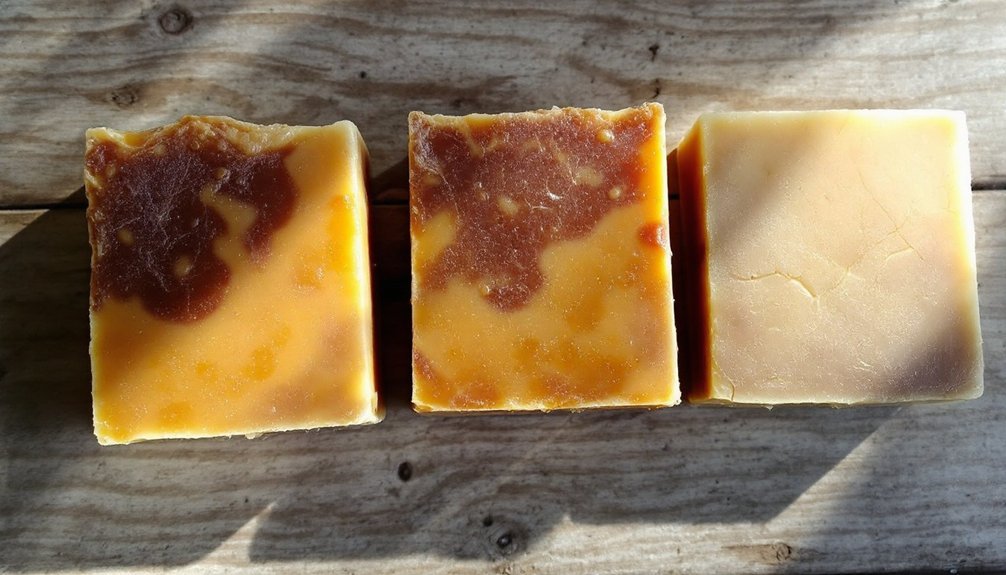



Leave a Reply